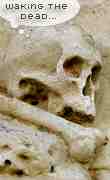 In our continuing exploration of the world of the Dead, Blather.net went in search of the Southwark Mysteries – the untold history of London. So, on a cold and gloomy 23rd of December 2005 we met with ‘John Crow’: a local poet and mystic who talks to the outcast dead…
In our continuing exploration of the world of the Dead, Blather.net went in search of the Southwark Mysteries – the untold history of London. So, on a cold and gloomy 23rd of December 2005 we met with ‘John Crow’: a local poet and mystic who talks to the outcast dead…
Christmas for the dead
It’s 7 pm. It’s bitterly cold and windy on Redcross Way, but so far there seems to be little threat of rain. Twelve of us look through the iron gates, into Crossbones Graveyard: some pause to read the strips of cloth tied the gate’s railings that contain the names of the dead. I can’t help but notice that Irish surnames seem to be frequent. People light candles, move around quietly and then, on John’s lead, the singing starts: “Silent night”, a Christmas song for the ghosts within – the ghosts of the unwanted, the forgotten and the invisible. Passers-by wonder what the hell is going on. One remarkably ignorant woman has a hissy fit when she discovers that one of the cars we came in, is parked 6mm across her precious garage. We ignore her. Christmas songs waft out the door of the pub behind us. And then we sing again.
The Invisibles
The outcast dead have always been a problem for those living within the comfortable confines of ‘acceptable’ society. Just what do you do with the remains of prostitutes, unwanted babies, disgraced women and mad people? Most cities, at some point in their history have had a paupers’ graveyard. And London, England is no different. The place known as ‘Crossbones Graveyard’ in Southwark, on the now fashionable South Bank (near the new Tate Modern museum) has been the last resting place of countless outcast dead, spanning a period of centuries, if not millennia.
View Larger Map
At the time of the Roman establishment of London, Southwark was an inhospitable marshland. But, the river was much wider and shallower than it is now, affording easy crossings – which proved useful in the disposal of unwanted things. It was at this location, a classic “liminal zone”, that the Romans chose to build the first bridge to London on the north bank. On the south they built roads, shops, houses and fortifications. The London Bridge was the only bridge for centuries.
In 1107, the Bishops of Winchester controlled the area, their power ending at the area that became known as the ‘Liberty of the Clink’. Activities forbidden within the city were openly carried out in the Liberties of the area now known as Southwark. Amusements included bear pits, brothels (or ‘stews’) and other assorted dens of iniquity. The prostitutes, in reference to the politically dominant men of the cloth, became known as the ‘Winchester Geese’. The bodies of these women, along with the countless hordes without money at the time of their deaths were buried in Crossbones Graveyard. Without markers. No headstones. Quicklime and a shallow pit. Forgotten and discarded.
Goose and Crow
But, skip forward to the early 1990’s and the outcast dead make themselves known again: during the construction of the London Underground’s Jubilee line, a mass of human remains were discovered at Crossbones, excavated and later displayed at the Museum of London. And now, Crossbones sits empty. A wasteland of tarmacadam and weeds. But one man wants to change all that: the local Southwark poet and dramatist John Constable, who uses the pen name of ‘John Crow’ when telling the story of ‘Goose’ and the Southwark Mysteries.
The Southwark Mysteries were allegedly revealed to John Crow, trickster familiar of the Southwark poet and playwright John Constable, by The Goose, the spirit of a medieval Bankside whore, licensed by the Bishop of Winchester to ply her trade within The Liberty of The Clink. In Constable’s apocalyptic vision, John Crow encounters The Goose at Crossbones, the whores’ graveyard unearthed during work on the Jubilee Line Extension. She initiates him into a secret history spanning 2000 years, a healing vision of the Spirit in the flesh, the Sacred in the profane, Eternity in time…
And now, at 7 pm on the 23rd of each month, Constable goes to the Crossbones graveyard in Southwark to hold a short ceremony (of no particular religion) to remember the outcast dead. All are welcome.
What now for the Geese?
Constables’ eventual aim is to raise public awareness of the story, engender interest and enable the local community to reclaim ownership of the historical fabric of the area. Finally, he hopes, some form of proper memorialisation can be done at the site. He seems to like the idea of a garden. In addition to the monthly ceremonies, Constable has furthered the cause by the creation and performance of the Southwark Mysteries play, as well as a wonderful education programme for local schools, complete with workbooks and field trips. He also does regular walks, the detail of which are contained on the Southwark Mysteries website.
More:
Watch the Southwark Mysteries (Real player needed)
Southwark Mysteries
Location of Crossbones Graveyard
Thanks:
A big thankyou to Christina at Treadwells‘ for alerting us to the Crossbones story
Artwork:
Photograph by damien. Manipulation by miss w. tod
Waking the Dead:
Full list of all articles in the Waking the Dead series
